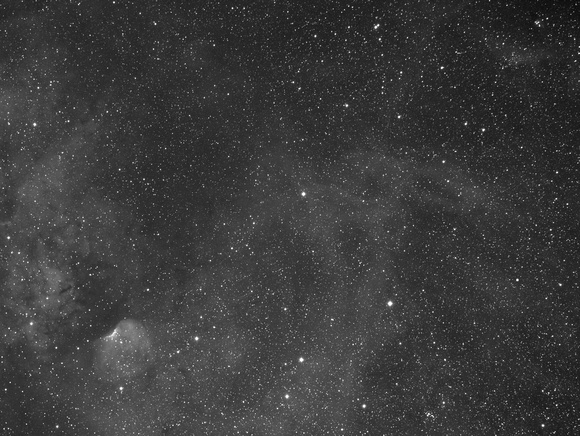Region around Alkurhah
Here we have some Hydrogen nebulas around Alkurhah, a star in Cepheus. Alkurhah is the star at the image center. In the lower left is Sh2-140, while the diffuse nebula near the center of the image is Sh2-137. In the upper right, we can see NGC7129 and on the right edge half way down from the center is planetary nebula NGC7139. The real treat in the image was supposed to be IsWe2 which my charts identify as a planetary nebula. You can see a faint outline of its spherical shell at the image top to the left of the center.
The noise in the image is just too large in this image to get all the finer details out. Understandable, given that this was imaged under a full moon. The main reason for this outing was to trouble shoot a couple of problems (see details below if you care), so I am not too upset about not having a high quality image.
Technical details:
Date: July 5th, 2012
Time: 12:30am - 4am
Camera: SBIG STF-8300M
CCD Temperature: -10C
Lens: Canon 200mm f/2.8 stopped down to 58mm
Filter: Astrodon 5nm H-alpha
Light frames: 10x20 min
Dark frames: 20
Flat frames: 20
Guiding: Orion SSAG @ 80/400mm Orion Short tube
Mount: Losmandy GM-8
Dithering: Manual
Processing: Stacking in DeepSkyStacker, Curves and levels in PSCS5.
Other notes: A lot more work went into this image than usual. A couple of nights ago I had a session where everything went wrong. The polar alignment scope was somehow whacked out of alignment, and the RA axis on my mount was far noisier than ever before - too much for my autoguider to handle. Finally, in my IC5068 image, I noticed a strange diagonal banding noise which I wanted to hunt down. All these things led to this full moon outing were I wasn't too concerned with the final image, but more with fixing things. I approached the problems as follows:
1) Polar scope: I couldn't fix the polar scope at home. With the polar scope out of commission, I needed a different polar alignment technique. I ended up using a PHD assisted drift alignment. The procedure is fairly easy and I was very confident that I got my alignment spot on. However, DeepSkyStacker noticed some field rotation between frames pointing to my alignment still being a bit off. The individual frames don't show apparent field rotation though.
2) Noisy RA axis: I ended up just taking the RA axis apart, stripping the grease, and regreasing everything. What a difference this made. In the past, the RMS error would usually be ~0.5 pixels at 400mm focal length. With the reworked RA axis, I got this number down to 0.25 pixels RMS ... in windy conditions! Once the wind died down, the RMS error went down to lt;0.15 pixels RMS. Keep in mind that even though I am guiding at 400mm focal length, I am imaging at 200mm, so the RMS error on the imaging chip is lt;0.08 pixel (~same pixel size on guider and imaging CCD). In therms of guiding, this was the best night I've ever had. Both DEC and RA guide curves were practically flat lines.
3) Diagonal banding noise: My previous image, showed diagonal banding, which limited how much I could stretch the final image. The folks on the cloudynights forum suggested that this noise could be due to interference between cables of the CCD. I ended up separating the CCD's power and the USB cords, making sure that they didn't cross paths. The diagonal banding is no longer present.
Overall, this a noisy image I am not very proud of. If I end up with an open spot in my imaging schedule, I'll try to reshoot this under a new moon.


